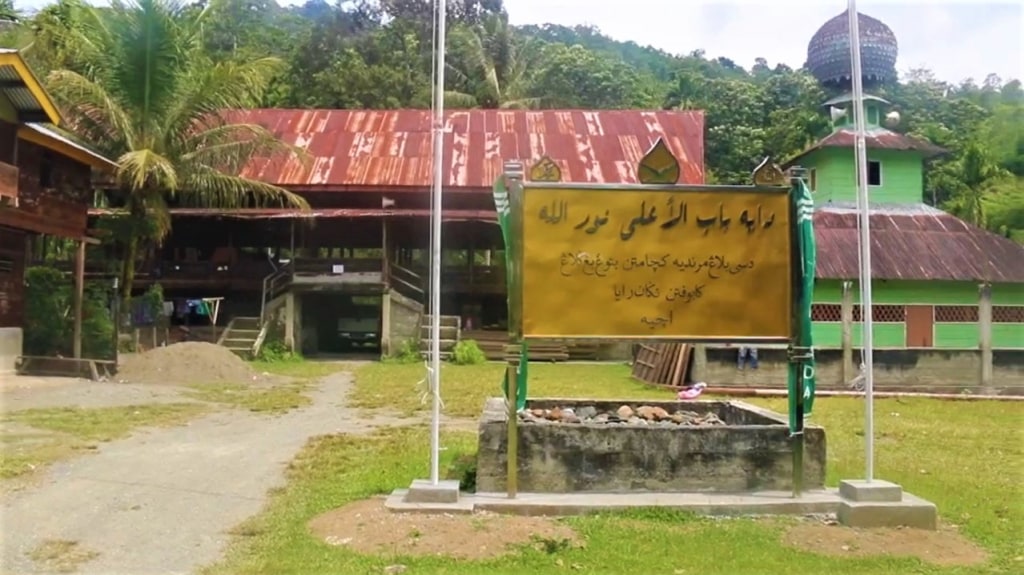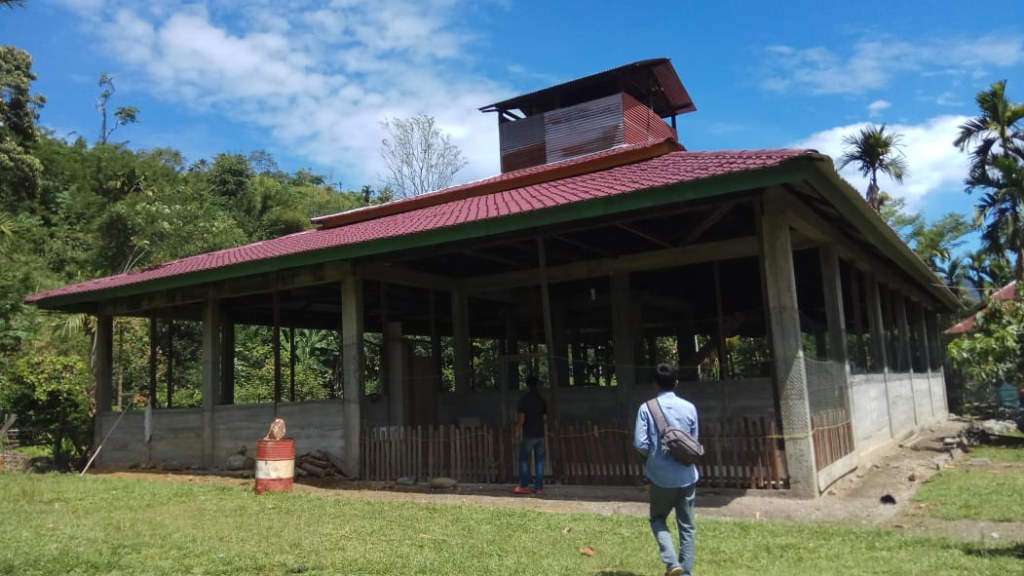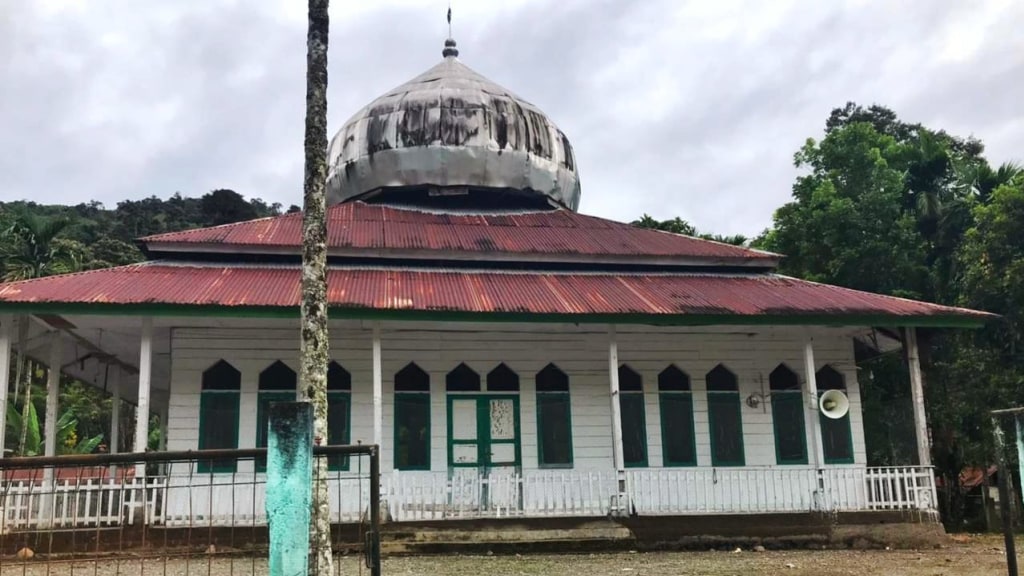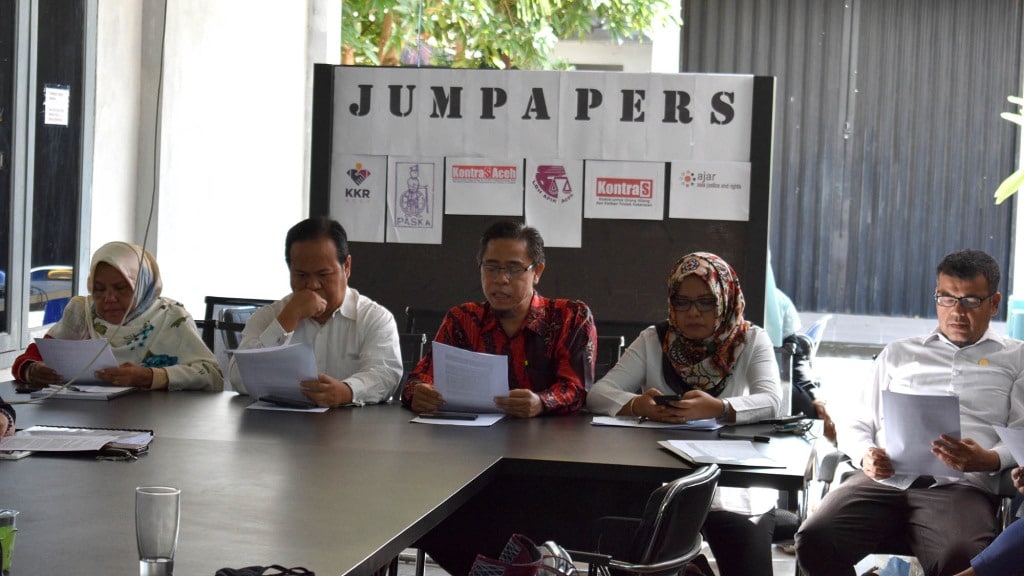The author is a fellowship recipient of human rights, media and transitional justice training organized by AJI Banda Aceh, KontraS Aceh, LBH Banda Aceh and AJAR.
[Siti Aisyah/Acehkini]
The faint chanting of the evening call to prayer was heard from a distance. We stopped by a hut on a hill facing the ravine. Under the pouring rain, the cold creeped along with the thin fog. Visibility was increasingly limited. The lights were can faintly be seen from residential areas in the Beutong Ateuh Benggalang District, Nagan Raya Regency, Aceh.
At exactly 18:45 WIB, my cell phone rang. The caller was Yusri, the treasurer of Blang Puuk Village, one of the villages there. “Assalamualaikum. Have you arrived yet?” he asked. “Already at the hut on the edge of the cliff,” I replied.
“It's not far away, about a kilometre journey to get here,” concluded Yusri.
We continued our journey by motorcycle under the drizzle. Ten minutes had passed. Villager's houses began to be visible one after another, until we arrived at the iron bridge that connected to the center of Beutong Ateuh Benggalang subdistrict. On the left side was the office of the District Police (Polsek) and the Beutong Ateuh District Military Post. On the opposite were several grocery stores that have just opened.
After crossing the bridge, Yusri welcomed us and guided us to his house, about 500 meters from the end of the bridge. Yusri's wife served us hot tea while accompanying us. The cold delivered drowsiness, and we fell asleep in that house.
Visiting Beutong Ateuh Benggalang, I and several other journalists had an agenda. We wanted to record the condition of the inland region on the border of Nagan Raya and Central Aceh. With regards to development, natural beauty and people's memory of the tragedy of past human rights violations.

Saturday morning, 9 January 2021, the sun appeared on the horizon. The gentle breeze brought coolness accompanied by singing birds and noisy crickets. Yusri's wife had breakfast prepared for us. Soon after, Yusri took us around the village.
Away from city noise, Beutong Ateuh District was located in the valley of Mount Singgah Mata, and flanked by Mount Abong-abong and Mount Tangga, in the Bukit Barisan cluster. With an area of approximately 585.88 kilometers square, there were five villages there: Blang Puuk, Blang Meurandeh, Kuta Teungoh, Babah Suak Village and Pintu Angen.
Located about 75 kilometers from the center of Nagan Raya Regency, this location must be traversed by underwent uphill and turns, and passing through Mount Singgah Mata which altitude was 2,800 meters above the sea level.
Yusri exposed, the people there depended their lives on the fertile land by farming, cultivating and raising livestock. This area was also rich in natural resources. Its’ gold content was almost exploited by a mining company once, but residents refused the mining company’s presence.
The Tragedy of Aceh Conflict Period
Behind the serene nature, Beutong Ateuh stored old memories that have not faded from the people's memories. The tragic story of the massacre of Teungku (Tgk) Bantaqiyah and his students at Babul Mukarram Islamic Boarding School on 23 July 1999 by the Indonesian Armed Forces (Tentara Nasional Indonesia/TNI). At that time the conflict was still flogged, after Free Aceh Movement (Gerakan Aceh Merdeka/GAM) had declared Aceh's independence since 4 December 1976.
Teungku Bantaqiyah is a well-respected dominie in Aceh. At that time, his Islamic boarding school was still part of the West Aceh district. He is known as a consistent dominie. Therefore, many negative images were created and widespread to damage the Teungku's reputation.
He was once diminished by a number of issues such as teaching deviant sects, but he was not affected. His recitations were never empty. Had been withstood the issue of deviant sects, Bantaqiyah was then hit by the issue of marijuana legalization. In 1993, the authorities arrested Teungku Bantaqiyah on the grounds of ownership of a cannabis garden, with which he was accused to support the Security Disturbance Movement (Gerakan Pengacau Keamanan/GPK), the government's official term -at that time- for GAM. This case led to his being sent to Tanjung Gusta Penitentiary in Medan. He was sentenced to 20 years in prison.
The wave of reformation that took place in Indonesia caused Suharto and his New Order regime to collapse by the student movement in May 1998. This brought BJ Habibie to the pinnacle of power. In Habibie’s era, political prisoners and political convicts were granted amnesty. Bantaqiyah is one of the political convicts given amnesty by President Habibie.

After being freed from Tanjung Gusta, Bantaqiyah returned to his village in the inland of Nagan Raya. Eversince his return to Beutong Ateuh on 28 May 1999, Tgk Bantaqiyah no longer wanted to teach a recite. However, at the request of the community, he finally re-opened the recitation. Every Friday, villagers came to the hall to study Al-Quran and kitab kuning, until the tragedy occurred before Friday prayers, 23 July 1999.
The massacre started around 11.00 WIB, Tgk Bantaqiyah and dozens of his students were at the recitation hall when hundreds of TNI personnels came to the boarding school. They shouted and order for everyone to gather. Islamic boarding schools were suspected of storing weapons and supporting GAM, but these accusations were never proven.
There had been a dialogue between Bantaqiyah and the authorities, but the contents were not known. Suddenly, a number of soldiers opened fire. The Teungku gave a signal for the residents and students to lay down on the grown to avoid being shot.
Panic, cries and screams clashed between the bullets. Tgk Bantaqiyah fell on the third shot. Before Friday prayer, the Tengku Bantaqiyah recitation hall had turned into a killing field.
In the report submitted by KontraS and Coalition of Aceh Human Rights NGOs, it was recorded that 57 residents of Babul Al-Mukarramah Islamic Boarding School became victims, including Tgk Bantaqiyah. There were 34 people died at the Islamic boarding school, while 23 other residents of the Islamic boarding school were found a few days later in a 7-kilometer ravine along the Beutong Ateuh-Aceh Tengah route.
The case received serious highlight from the country. President BJ Habibie issued Presidential Decree No. 88 of 1999 concerning the Independent Commission for Investigating Acts of Violence in Aceh (Komisi Independen Pengusutan Tindak Kekerasan di Aceh/KIPTKA). The tragedy was investigated and a number of perpetrators were brought to justice through the Connectivity Court.
A total of 25 TNI soldiers were brought to court to be held accountable for their actions. The first trial at the Connectivity Court in Banda Aceh was held on Wednesday, 19 April 2000. Only one person responsible for the massacre who was unable to be brought to justice, Lieutenant Colonel Sudjono, at that time served as Pasie Intel Korem 011/Lilawangsa. Until now, his whereabouts were still a mystery.

“Tragedy occurred in Blang Meurandeh Village,” said Yusri. Blang Meurandeh is a neighboring village of Blang Puuk where Yusri lives. Yusri took us there. On our way, we passed by the Babul Mukarramah Islamic Boarding School which was the massacre site of the dominie and his students. The place looked deserted. From outside the fence, seemed like there was no activity. After stopping for a moment, we continued our journey to Tgk Malikul Aziz's house. He is the son of Tgk Bantaqiyah who is currently the leader of the boarding school inherited from his father.
In a long-sleeved black shirt and a cap on his head, he came to meet us. Tgk Malikul asked about on what intention we came. However, when he was flicked about the 1999 tragedy, his face immediately changed. His voice raised. He did not want to remember, let alone discuss the event.
“Because the Beutong people are all victims of the conflict. It would only piss people off. Why ask questions about the (past) conflict again?” he said in Acehnese.
Tgk Malikul Aziz said he was reluctant to remember let alone discuss the incident because it would only open up dark memories. According to him, when it came to caring after the incident, there was almost nothing at all. In his memory, there was only personal assistance from a central official of Rp 800 million. “With that money, a mosque was built. As for the conflict victims, it was given to other people. You can ask the person who received it, because I don't accept it,” he said.
After that aid, continued Malikul Aziz, the victims never received any kind of attention nor assistance. “There was no assistance, let alone psychological recovery. There was none. You don't need to think about it anymore, because it was never been given,” he said.
He said, if converted into rupiah, the losses suffered by his family due to the brutality of the apparatus who burned the boarding school and killed the livestock, reached IDR 2 billion. That's not to mention the loss caused by trauma for the victim's family.
“The boarding school were built with their own money, the congregation's alms money. It used to be all burned up. Just look at the condition of the dayah. It is now (rebuilt) from the congregation’s alms money, the alms of the villagers,” he explained.

Tgk Malikul Aziz said, in the past, he had proposed funding for the rehabilitation of the boarding school and for conflict victims through Aceh-Nias Rehabilitation and Reconstruction Agency (Badan Rehabilitasi dan Rekonstruksi/BRR). However, until now there is no definite news about this. Then they gave up and choose to keep that dark history and start a new life.
“The loss at that time, there's no need to bring it up again. Someone had already come but ignored us like the previous BRR proposal. Coming (here) and counted our losses which reached 2 billion, but it was not paid for,” he concluded.
Trauma Still Remains
Reluctant to talk about past memories also felt by R, one of the victims’ children. At the time of the incident, R saw firsthand how his father was tortured, then the authorities took him in a truck to Takengon (Central Aceh) under the pretext of wanting treatment. But then was finished.
During that time, R along with his mother and three older siblings had to fight hard to find his father's grave. After two years of searching with the help of residents, a tomb was found in a village in Central Aceh. Five months later, his mother became seriously ill and passed away.
“For two years we searched for it because at that time people didn't dare to tell. After finding out my father's grave, my mother was seriously ill,” he said.
Awalnya R sempat ingin bercerita tentang trauma yang dialaminya. Tapi belakangan menolak dengan dalih tidak ingin mengingat masa kelam yang hingga kini masih belum mendapat keadilan. “Udah dek, nggak perlu lagi di tulis ya, enggak penting semuanya, dari dulu banyak yang tanya ke keluarga kakak dari wartawan, tapi nggak ada perubahannya.”
“No need to ask anymore, it hurts. If you say we get equal rights, it can never be replaced by what people have done to the family. But we’ve been sincere,” concluded R, refused his identity to be written.
Yusri understood the attitude of the victims' families. According to him, the attitude shown by all conflict victims in their area was somewhat the same. They would be disturbed if they were asked about the dark past and the justice which until now has not been felt.
“If anyone discussed about the massacre, the conflict victims here would indeed be pissed off. They were disappointed. They haven’t wanted to bring the issue up again for a long time. They have been traumatized. We cried when we remember the incident because no one cares,” he said.
Another resident, Tarmizi, also said the same thing. He said that all the conflict victims in Beutong Ateuh Benggalang area had not received justice. Let alone psychological recovery, even the material compensation of what had been lost at that time had not been paid completely.
“After the conflict, there was never any (assistance) here. There was only a mosque beside the boarding school. Even that came from private money, not from the government. The government gave nothing at all. Not only were we victims, livestock such as the buffaloes were also victims. All of which were confiscated. What did they do wrong? Just animals, but was also murdered. Shot,” he concluded.
Meanwhile, Chairperson of the Working Group for Disclosure of Truth at Truth and Reconciliation Commission (TRC) Aceh, Evi Narti Zain, said that her party had not taken a comprehensive statement from the victims of the Teungku Bantaqiyah tragedy. “For Beutong Ateuh case, basically we have carried out an analysis of the case because there has been a legal verdict. But we have not taken the statement from every victim related to this case yet,” she said.
TRC Aceh themselves admitted that they had never carried out activities such as memorializing the victims in Beutong Ateuh because there were several factors that became obstacles. Few of them was time and a required special approach to the victims. He said that in the near future around 2021, TRC Aceh plans to visit there.
“Because how we work is to recommend reparations. Then for the reconciliation process, there must be a special approach. And what we will do there later is to establish memorialization. There have been initial talks with the boarding school’s leaders,” she said.

Head of TRC Aceh Afridal Darmi mentioned that the first mandate of TRC Aceh was to reveal the truth about human rights violations, and then to recommend reparations to the victims.
“Only after TRC reveals the truth, then we can talk about reparations, or in simple terms, to provide recovery assistance to victims so that they can recover from the sufferings of human rights violations,” he said.
“So, if we are asked about what assistance had we gave to the victims of Teungku Bantaqiyah tragedy, we cannot answer to that because truth disclosure has not been carried out yet (TRC),” he concluded. [ ]
Source: kumparan.com
